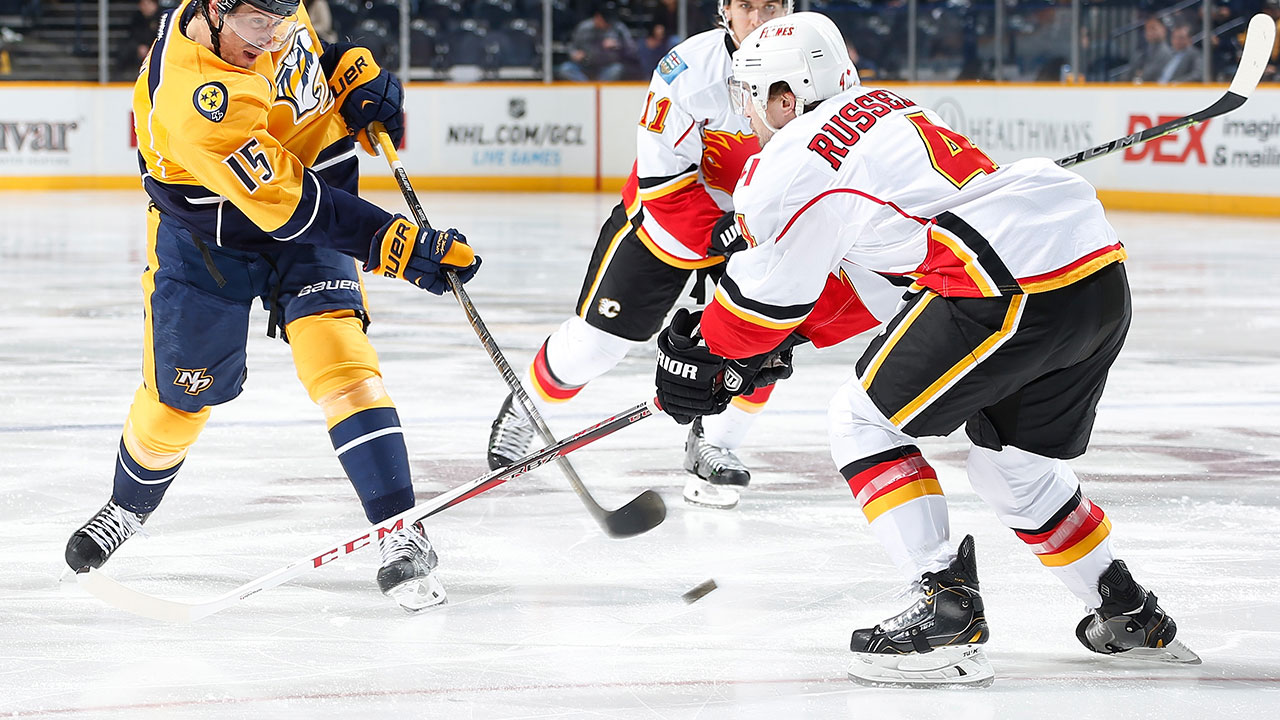Editor’s Note: This story was originally published in October 2014, prior to Kris Russell’s record-breaking shot-blocking party night.
Here’s our own Luke Fox on the secret to Russell’s shot-blocking success:
—
One less puck on net.
That’s how Kris Russell views the shot block, a brutal art he practised more times per game than any other player in the NHL last season. (Though his 201 blocked shots ranked him third overall in 2013-14, Russell’s 2.96 blocks per game were higher than that of NHL leader Andrew MacDonald.)
Russell’s fearless shins are on a similar pace this season. Averaging nearly three blocks a game through 10 games, he trails only Buffalo’s Josh Gorges in the category.
It’s an ugly job well-suited to the Calgary Flames’ top-four defenceman, who explains that stuffing pucks is more than playing fearless human shield. It takes timing, agility and slight of foot.
Once you get a taste… “I played on a junior team that kept stats on shot blocks, so that’s when I started to appreciate it and really focus on it. And your goalie really appreciates a shot block—unless you get in his way and screen him.”
Art of illusion: “You want to make the shooter think he has that lane. Then, at the last second, you take it away from him. Try to make them make the first decision. Now, saying that, there’s a lot of good players and a lot of fakes going on. If you go down too early, they’ll skate around you or get the shot through you.”
Blocks by design: “It’s a big part of the Flames’ strategy: less pucks to the net, less rebounds, it helps a goalie dealing with traffic. Usually when you block a shot and you’re in good position, you can transition the puck going the other way, so it benefits the offence as well. The coaches do a good job with video, showing you what lane you’re in and letting you know where you want to be.”
Hurts so good: “I’ve been pretty fortunate. Mostly bumps and bruises. I’ve broken a knuckle and a finger once, but thankfully it was my pinkie finger and my bottom knuckle, so it didn’t hinder my play.”
Keep your goalie happy: “If you’re gonna go down to block a shot, make sure you block it. If you’re in that shooting lane and the puck gets through you, it’s a screened shot. That gives the goalie less reaction time. You work with them, and there’s usually good communication between the D and the goalie, so as a defenceman you know how they want you to play certain shots.”
Hide ya face: “You don’t want to get down too low too quick and take one in the neck or chin – or the face for guys who don’t wear visors. When I get in that kneel block, I like to tuck my chin in my shoulder pads and look at the guy to see when the puck’s coming. That way I’m semi-protected by my shoulder pads.”
Pedi-cure: “Everyone in Calgary uses [shot blockers on their skates]. I don’t mind them. It’s like anything: you play enough with them, you don’t even realize they’re there.”
Bedeviled: “One game against New Jersey they had us hemmed in [our zone] late, and we were up by a goal. They had their goalie pulled, and I had two or three blocked shots right in a row. That got the boys standing up, because it was a big part of the game and they had all the momentum.”
Sticking point: “The important thing is having a good stick. You can block a lot of shots and take lanes away just by the position of your stick or your body. Know where you are on the ice. You always want to be between the [opposing] player and the net and make sure you’re ready to jump in that lane if they take that extra step. You always gotta be moving with the guy as well.”
It runs in Red Deer: “The Vandermeer family was full of great hockey players. All of them played pro. Joe [Vandermeer] was a smaller, left-shooting defenceman and really smart positioning-wise and with his stick. Growing up, I tried to model my game after him.”
The one he fears most: “A lot of guys have heavy shots. I don’t face P.K. too much, but [Shea] Weber is one D on the power-play who has a tough shot to block. I played quite a bit against him when I was with Columbus, but I haven’t caught one of his big one-timers yet.”

